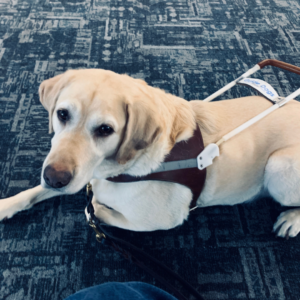Guide Dog Etiquette: What you should and shouldn’t do
You see a beautiful yellow lab sitting by his handler at the doctor’s office and it is understandably tempting to want to give the pooch a scratch behind the ear. But, you notice that this particular dog is wearing a harness or vest, signifying that he is a guide or service dog. You think it won’t hurt to sneak in a quick pat on the head or make noises to get his attention.
As tempting as it may be, it is important not to touch, interact, feed, or otherwise distract a service dog. This includes service dogs lying quietly underneath a restaurant table or sitting with their handler at a bus stop. It’s the guide dog’s responsibility to be vigilant of their surroundings. Distracting a guide dog can leave both the dog and their handler in a dangerous situation.
Here are a few more helpful tips on positively interacting with blind and visually impaired people who travel with guide dogs:
-
- Always ask before petting or interacting with any dog, especially guide dogs. Simply ask the handler if you can pet their dog. Some handlers will allow for a quick interaction if they have the time. If you have small children who don’t know better, try your best to make sure they don’t get too close to the service animal.
- If you are walking your pet dog and see a guide dog team, do not allow your dog to wander over for a “meet and greet” with the guide dog. This can be very distracting to the dog.
- Always speak to the blind person directly, not to their sighted companion or to their guide dog.
- If you believe a person with visual impairments needs help finding something, simply ask if they need help and how you can best assist them.
- Never grab the guide dog’s leash, collar, or harness. The guide dog is trained to take commands from their handler.
- Do not try to coax a guide dog forward or direct them in any way. This is the responsibility of the handler.
- Sometimes a handler will want you to be a “sighted guide.” To do this, they will hold on to your left arm, just above the elbow. Because of this, the guide dog will not actually be guiding its handler. You will need to relay any critical information to the handler, such as upcoming stairs, narrow passages, and doorways.
 As you see, service dogs play a vital role in a person’s health and well-being with a disability. When they are on the job, you mustn’t interrupt or distract them. If you are unsure of how to interact with a service animal, just ask. Every handler and guide dog team are different but asking thoughtful questions is a great place to start!
As you see, service dogs play a vital role in a person’s health and well-being with a disability. When they are on the job, you mustn’t interrupt or distract them. If you are unsure of how to interact with a service animal, just ask. Every handler and guide dog team are different but asking thoughtful questions is a great place to start!
Stay tuned this month as Clovernook Center celebrates National Guide Dog Month to raise awareness, appreciation, and support for guide dogs in our community. Did you miss our last post? Click here to hear from Mambo, the guide dog, about his role as a service animal.
